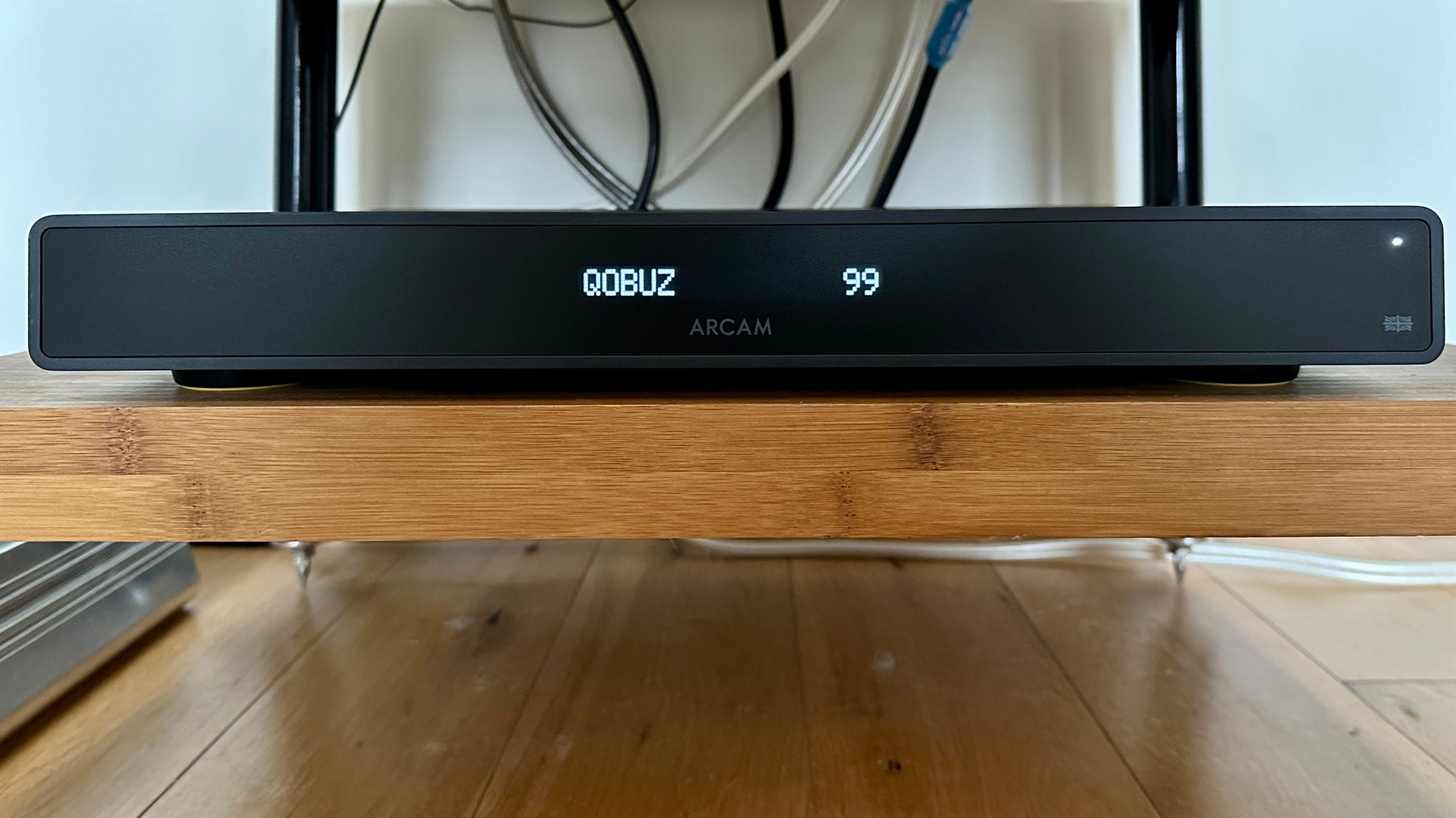Verdict
Opinion as to who first said “those who like this sort of thing will find this the sort of thing they like” is divided – but that won’t stop me from applying it to the Arcam ST5.
Pros
- Big, welcoming sound
- Physically slim and discreet
- Decent specification
Cons
- Polite isn’t always a positive sonic trait
- No Bluetooth
- Convoluted and over-involved to control
-
File supportUp to 24-bit/192kHz hi-res playback -
DACPowered by ESS Sabre ES9018 DAC -
OperationBoth remote and app control
Introduction
The music-streaming land-grab shows no signs of slowing down – if anything, the arrival of high-performing newcomers like Eversolo and WiiM has made the competition tougher than ever.
So it’s with a due sense of trepidation/excitement that we welcome Arcam (back) to the fray with its first music streamer since 2020’s ST60. Does the veteran brand have what it takes to see off the upstarts?
Availability
The Arcam ST5 music streamer is on sale and in the United Kingdom it sells for £799. In the United States it will set you back $799, while in Australia the going rate is AU$1499.
That means Arcam has pitched the ST5 into an area of the market that has lately been dominated by Cambridge Audio, but which is coming under ever-increasing pressure from the likes of Bluesound, Eversolo and plenty more besides…
Design
- 57 x 431 x 344mm (HxWxD)
- No fascia controls
- Minimal display
There’s minimal, and then there’s minimal. Arcam seems to have set its mind to delivering as discreet and understated a music streamer as possible with the ST5 – and if that was indeed the company’s aim, I have to say it has succeeded.
The ST5 is recognisable as a member of Arcam’s new Radia series of components, if only from the yellow accents along the side of the casework and the brow covering the rear panel. There’s also an extremely brief company logo on the front panel, but other than this the design of the ST5 is approaching the anonymous.
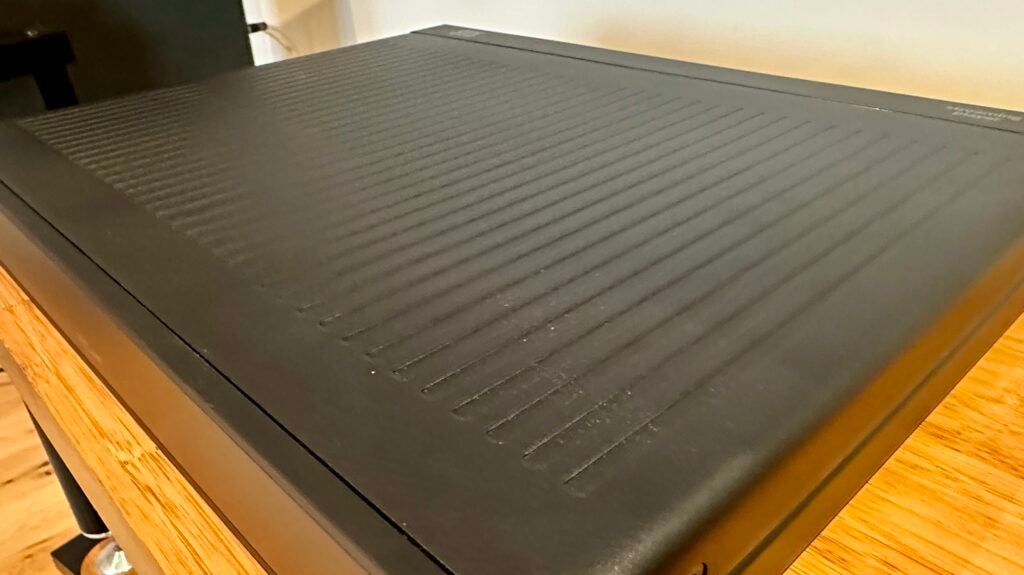
That’s by no means a bad thing, you understand. Some users may hanker after the sort of full-colour OLED display featured on streamers from the likes of Cambridge Audio, but Arcam has decided to concentrate the ST5’s processing power on audio performance. And anyway, there’s a fairly big (and fairly fuzzy) single-line display on the fascia to help you when making any operational adjustments – which is more than the likes of Bluesound is prepared to offer.
There is just one physical control: a power on/off rocker on the rear panel, next to the mains power input. Apart from this, the ST5 is a hands-off design.
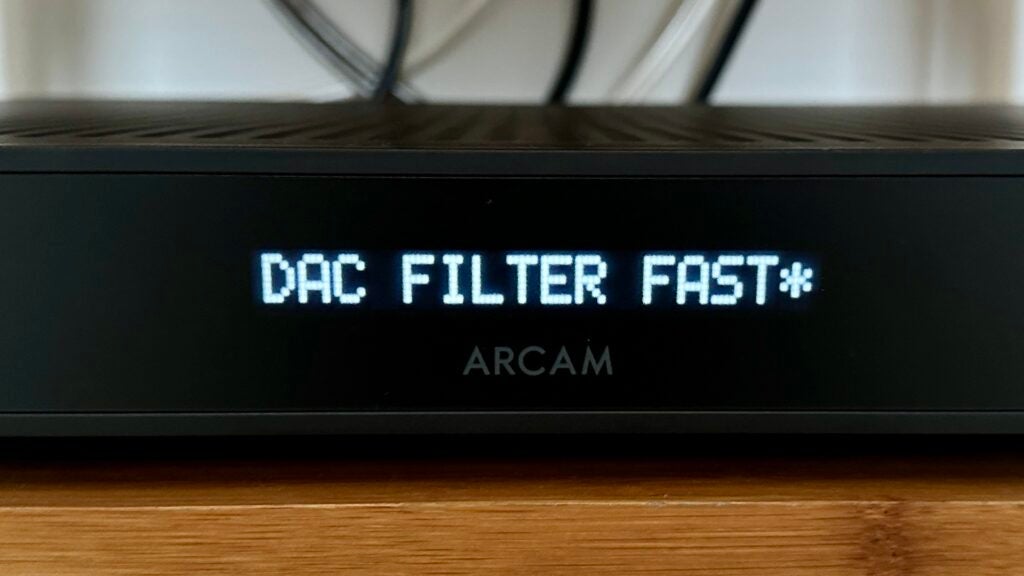
Features
- 24-bit/192kHz hi-res playback
- Wired and wireless inputs…
- …but no Bluetooth
With one notable exception, options for getting audio content into and out of the Arcam are perfectly adequate. On its rear panel the ST5 has an Ethernet socket and a USB-A slot as inputs, and digital optical, digital coaxial and analogue stereo RCA outputs. Wireless options extend to Wi-Fi (of course), Apple AirPlay 2, Chromecast, and the Connect versions of Spotify and TIDAL.
The control app (on which there will be a little more a little later) also gives access to internet radio, podcasts, Amazon Music, Qobuz and UPnP devices on a common network. The Arcam is also Roon Ready.
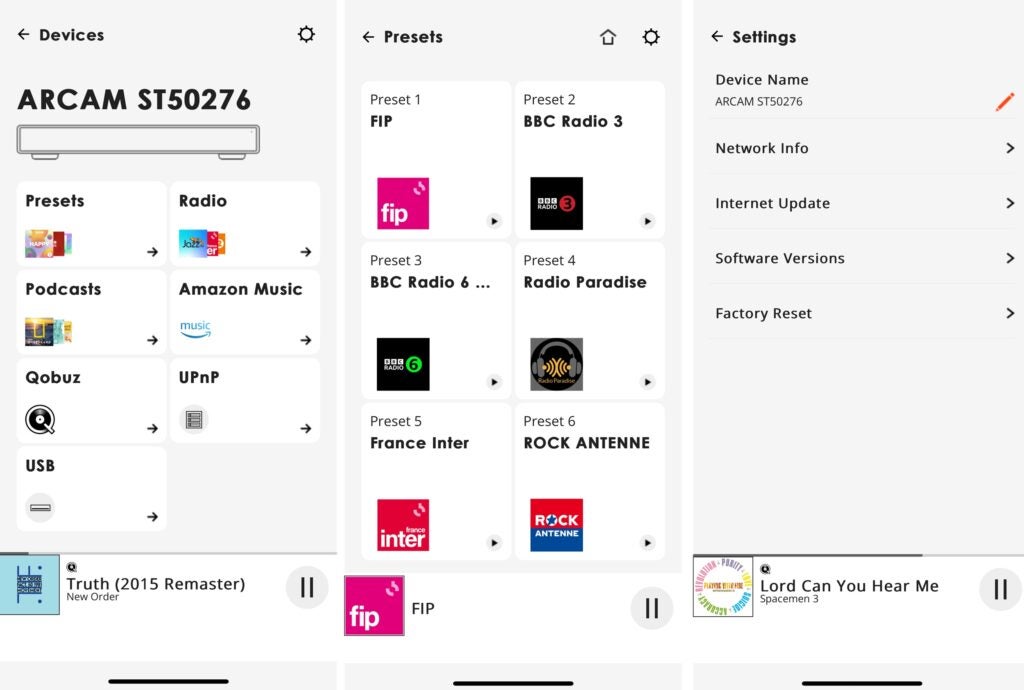
What there’s no sign of, though, is Bluetooth connectivity. Obviously, Bluetooth is hardly a paradigm of audio quality, but it’s a simple and convenient way of accessing music without recourse to Wi-Fi, and as such is a feature of every other music streamer I can think of. Is Arcam brave or foolhardy for omitting it? You decide…
Doing the crucial digital-to-analogue conversion business is the ubiquitous ESS Sabre ES9018 chipset. It’s ready to deal with all worthwhile digital audio file types (including FLAC and MQA) and can handle resolutions of up to 24-bit/192kHz and DSD128. Hardcore streaming fans will want to see bigger numbers than those, but for the overwhelming majority of users with this sort of money to spend on a music streamer, they’ll do just fine.

As far as controlling the ST5 is concerned, things are a little more convoluted than is ideal. The Arcam Radia control app is free for iOS and Android, and it’s just as stripped-back and minimal an affair as the streamer it controls. Here’s where you can choose your input (or, at least, the majority of them – Spotify and TIDAL are not embedded in the app, so you’ll need to use their native equivalents), select one of six presets (for radio stations only – you can’t specify a playlist or a podcast for some reason) and control playback as far as volume, play/pause and the other basics are concerned. You can also check for firmware and software updates here.
The ST5 ships with a quite nicely realised little remote-control handset that’s a cut or two above the norm. It duplicates some of the obvious stuff – volume, playback control and what-have-you – and it also lets you navigate the menus accessible via the machine’s single-line display.
Here’s how you select your preferred output type (digital or analogue), DAC filter (fast or slow), choose fixed or variable volume output, and other niceties. I’d have thought including these options in the control app would be sensible – after all, this way the entire ST5 can be controlled from one place. But it turns out (not for the first time) that I’m wrong.
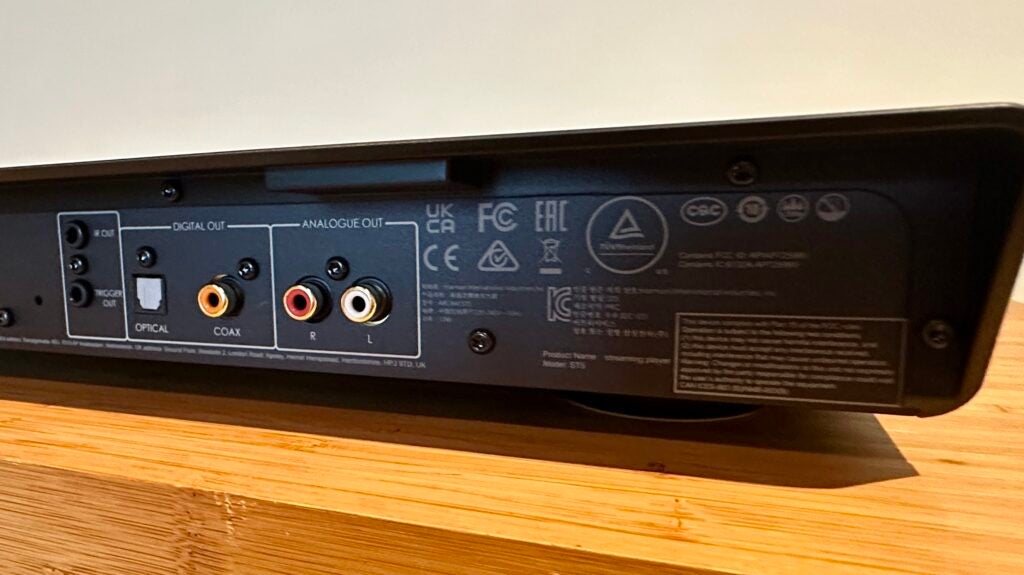
Sound Quality
- Hefty, unthreatening sound
- Warm, expansive presentation
- Not exactly the last word in attack
It’s a bit of a stereotype, sure – but stereotypes are rooted in truth, aren’t they? Broadly, the Arcam ST5 sounds so much like a stereotypical Arcam product it’s almost like a tribute act.
The ST5 has a comfort zone, and it’s a broad, warm, inviting and utterly unthreatening comfort zone at that. It’s a place where low frequencies are big and substantial, where the opposite end of the frequency range is far too polite to ever suggest it might get hard, edgy, or otherwise out of hand, and where the midrange communicates politely rather than explicitly. And rather than allow uncooperative recordings to make it feel uncomfortable, the ST5 simply co-opts them into its world of lush, pleasant, and amicable sound.
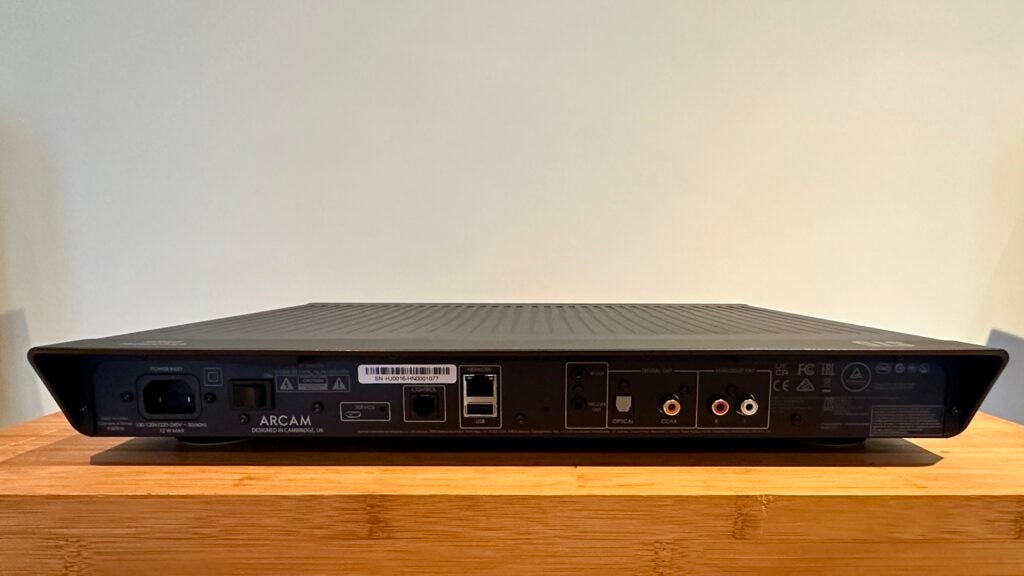
Of course, it’s an approach that works a treat with content that’s this way disposed in the first place. A 24-bit/192kHz Qobuz-derived FLAC file of Nico’s version of I’ll Keep It With Mine rolls along in fine style – the Arcam’s tonality suits the string arrangement beautifully, the vocal is unmistakable in its tone and timbre, and what low-frequency information there is arrives with depth, weight and momentum.
The ST5 does good work in unifying both the frequency range and the performance as a whole, offers decent insight, and creates a fairly large and nicely organised soundstage. The Arcam is right at home with stuff like this, and as a consequence the sound it serves up is confident, coherent and welcoming.

A 24-bit/44.1kHz FLAC file of Non-Alignment Pact by Pere Ubu, on the other hand, fares rather less well. This is the snotty, attitudinal, raucous product of a superior garage band with ideas above its station, and as such is sufficient to make the Arcam sound uncomfortable. The edginess at every stage of the frequency range, from the scuzzy bass guitar to the clattering percussion via some howlingly abrasive feedback is anathema to the ST5 – but its attempts to smooth off the rough edges, roll off the shrill attack and generally bring some order to bear are doomed to failure. The result is a compromise that suits nobody.
In some ways, this safety-first approach could work to the ST5’s advantage. Not every system has its eyes out stalks, after all, and the Arcam’s benign attitude means that it should work well with any number of amplifier/loudspeaker combinations. But if it’s a complete and unadulterated account of your music you want – for better or for worse – this is not a music streamer that will automatically give it to you.
Latest deals
Should you buy it?
You value a broad, welcoming and unthreatening sound
There’s a lot to be said for an inclusive sound that’s likely to be system-agnostic
You’re hoping for the complete sonic picture
It’s all done in the name of ‘good taste’, but the ST5 tries to impose order at all times
Final Thoughts
I hadn’t listened to a piece of Arcam equipment in quite a while, but it didn’t take long in the ST5’s company for it all to come flooding back. Personally, I think the risk-averse attitude of this streamer is understandable and, in some ways, commendable – but it means it’s not the all-rounder the asking-price suggests it should be.
How we test
We test every music streamer we review thoroughly over an extended period of time. We use industry standard tests to compare features properly. We’ll always tell you what we find. We never, ever, accept money to review a product.
Find out more about how we test in our ethics policy.
Tested with real world use
FAQs
You can stream over Wi-Fi with the Arcam ST5, but it does not have any Bluetooth support.
Verdict
Opinion as to who first said “those who like this sort of thing will find this the sort of thing they like” is divided – but that won’t stop me from applying it to the Arcam ST5.
Pros
- Big, welcoming sound
- Physically slim and discreet
- Decent specification
Cons
- Polite isn’t always a positive sonic trait
- No Bluetooth
- Convoluted and over-involved to control
-
File supportUp to 24-bit/192kHz hi-res playback -
DACPowered by ESS Sabre ES9018 DAC -
OperationBoth remote and app control
Introduction
The music-streaming land-grab shows no signs of slowing down – if anything, the arrival of high-performing newcomers like Eversolo and WiiM has made the competition tougher than ever.
So it’s with a due sense of trepidation/excitement that we welcome Arcam (back) to the fray with its first music streamer since 2020’s ST60. Does the veteran brand have what it takes to see off the upstarts?
Availability
The Arcam ST5 music streamer is on sale and in the United Kingdom it sells for £799. In the United States it will set you back $799, while in Australia the going rate is AU$1499.
That means Arcam has pitched the ST5 into an area of the market that has lately been dominated by Cambridge Audio, but which is coming under ever-increasing pressure from the likes of Bluesound, Eversolo and plenty more besides…
Design
- 57 x 431 x 344mm (HxWxD)
- No fascia controls
- Minimal display
There’s minimal, and then there’s minimal. Arcam seems to have set its mind to delivering as discreet and understated a music streamer as possible with the ST5 – and if that was indeed the company’s aim, I have to say it has succeeded.
The ST5 is recognisable as a member of Arcam’s new Radia series of components, if only from the yellow accents along the side of the casework and the brow covering the rear panel. There’s also an extremely brief company logo on the front panel, but other than this the design of the ST5 is approaching the anonymous.

That’s by no means a bad thing, you understand. Some users may hanker after the sort of full-colour OLED display featured on streamers from the likes of Cambridge Audio, but Arcam has decided to concentrate the ST5’s processing power on audio performance. And anyway, there’s a fairly big (and fairly fuzzy) single-line display on the fascia to help you when making any operational adjustments – which is more than the likes of Bluesound is prepared to offer.
There is just one physical control: a power on/off rocker on the rear panel, next to the mains power input. Apart from this, the ST5 is a hands-off design.

Features
- 24-bit/192kHz hi-res playback
- Wired and wireless inputs…
- …but no Bluetooth
With one notable exception, options for getting audio content into and out of the Arcam are perfectly adequate. On its rear panel the ST5 has an Ethernet socket and a USB-A slot as inputs, and digital optical, digital coaxial and analogue stereo RCA outputs. Wireless options extend to Wi-Fi (of course), Apple AirPlay 2, Chromecast, and the Connect versions of Spotify and TIDAL.
The control app (on which there will be a little more a little later) also gives access to internet radio, podcasts, Amazon Music, Qobuz and UPnP devices on a common network. The Arcam is also Roon Ready.

What there’s no sign of, though, is Bluetooth connectivity. Obviously, Bluetooth is hardly a paradigm of audio quality, but it’s a simple and convenient way of accessing music without recourse to Wi-Fi, and as such is a feature of every other music streamer I can think of. Is Arcam brave or foolhardy for omitting it? You decide…
Doing the crucial digital-to-analogue conversion business is the ubiquitous ESS Sabre ES9018 chipset. It’s ready to deal with all worthwhile digital audio file types (including FLAC and MQA) and can handle resolutions of up to 24-bit/192kHz and DSD128. Hardcore streaming fans will want to see bigger numbers than those, but for the overwhelming majority of users with this sort of money to spend on a music streamer, they’ll do just fine.

As far as controlling the ST5 is concerned, things are a little more convoluted than is ideal. The Arcam Radia control app is free for iOS and Android, and it’s just as stripped-back and minimal an affair as the streamer it controls. Here’s where you can choose your input (or, at least, the majority of them – Spotify and TIDAL are not embedded in the app, so you’ll need to use their native equivalents), select one of six presets (for radio stations only – you can’t specify a playlist or a podcast for some reason) and control playback as far as volume, play/pause and the other basics are concerned. You can also check for firmware and software updates here.
The ST5 ships with a quite nicely realised little remote-control handset that’s a cut or two above the norm. It duplicates some of the obvious stuff – volume, playback control and what-have-you – and it also lets you navigate the menus accessible via the machine’s single-line display.
Here’s how you select your preferred output type (digital or analogue), DAC filter (fast or slow), choose fixed or variable volume output, and other niceties. I’d have thought including these options in the control app would be sensible – after all, this way the entire ST5 can be controlled from one place. But it turns out (not for the first time) that I’m wrong.

Sound Quality
- Hefty, unthreatening sound
- Warm, expansive presentation
- Not exactly the last word in attack
It’s a bit of a stereotype, sure – but stereotypes are rooted in truth, aren’t they? Broadly, the Arcam ST5 sounds so much like a stereotypical Arcam product it’s almost like a tribute act.
The ST5 has a comfort zone, and it’s a broad, warm, inviting and utterly unthreatening comfort zone at that. It’s a place where low frequencies are big and substantial, where the opposite end of the frequency range is far too polite to ever suggest it might get hard, edgy, or otherwise out of hand, and where the midrange communicates politely rather than explicitly. And rather than allow uncooperative recordings to make it feel uncomfortable, the ST5 simply co-opts them into its world of lush, pleasant, and amicable sound.

Of course, it’s an approach that works a treat with content that’s this way disposed in the first place. A 24-bit/192kHz Qobuz-derived FLAC file of Nico’s version of I’ll Keep It With Mine rolls along in fine style – the Arcam’s tonality suits the string arrangement beautifully, the vocal is unmistakable in its tone and timbre, and what low-frequency information there is arrives with depth, weight and momentum.
The ST5 does good work in unifying both the frequency range and the performance as a whole, offers decent insight, and creates a fairly large and nicely organised soundstage. The Arcam is right at home with stuff like this, and as a consequence the sound it serves up is confident, coherent and welcoming.

A 24-bit/44.1kHz FLAC file of Non-Alignment Pact by Pere Ubu, on the other hand, fares rather less well. This is the snotty, attitudinal, raucous product of a superior garage band with ideas above its station, and as such is sufficient to make the Arcam sound uncomfortable. The edginess at every stage of the frequency range, from the scuzzy bass guitar to the clattering percussion via some howlingly abrasive feedback is anathema to the ST5 – but its attempts to smooth off the rough edges, roll off the shrill attack and generally bring some order to bear are doomed to failure. The result is a compromise that suits nobody.
In some ways, this safety-first approach could work to the ST5’s advantage. Not every system has its eyes out stalks, after all, and the Arcam’s benign attitude means that it should work well with any number of amplifier/loudspeaker combinations. But if it’s a complete and unadulterated account of your music you want – for better or for worse – this is not a music streamer that will automatically give it to you.
Latest deals
Should you buy it?
You value a broad, welcoming and unthreatening sound
There’s a lot to be said for an inclusive sound that’s likely to be system-agnostic
You’re hoping for the complete sonic picture
It’s all done in the name of ‘good taste’, but the ST5 tries to impose order at all times
Final Thoughts
I hadn’t listened to a piece of Arcam equipment in quite a while, but it didn’t take long in the ST5’s company for it all to come flooding back. Personally, I think the risk-averse attitude of this streamer is understandable and, in some ways, commendable – but it means it’s not the all-rounder the asking-price suggests it should be.
How we test
We test every music streamer we review thoroughly over an extended period of time. We use industry standard tests to compare features properly. We’ll always tell you what we find. We never, ever, accept money to review a product.
Find out more about how we test in our ethics policy.
Tested with real world use
FAQs
You can stream over Wi-Fi with the Arcam ST5, but it does not have any Bluetooth support.


















